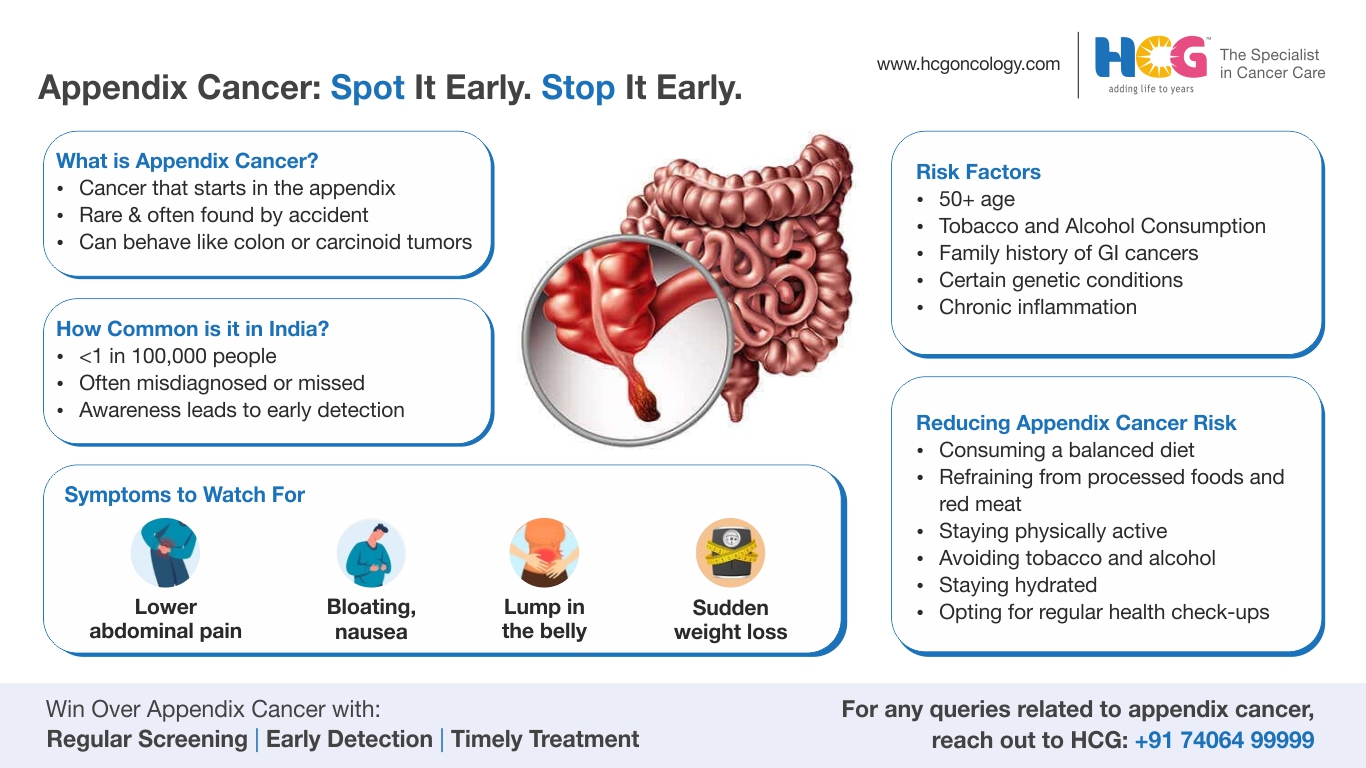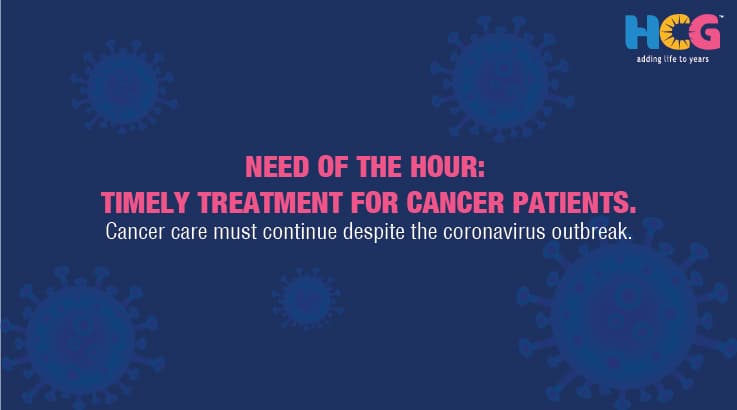
08 Nov, 2025
Feel free to reach out to us.

08 Nov, 2025

This article is medically reviewed by Dr. Sunit Lokwani, Consultant - Medical Oncology and Clinical Hematology, HCG Cancer Centre, Indore.

Appendix cancer is also known as appendiceal cancer. It is quite a rare condition and develops due to an appendix cell mutation, resulting in tumor formation.
The appendix is located near the junction of the small and large intestines. The key functions of the appendix include maintaining the gut flora and regulating immune response.
Appendiceal cancer can be benign or malignant. Over half of the cases of appendix cancer are devoid of symptoms. Most cases are detected incidentally during imaging or surgery for other conditions.
Appendix cancer is divided into two types, i.e., epithelial and neuroendocrine, based on the cell of origin.
The month of August is officially designated as Appendix Cancer Awareness Month. It aims to enhance awareness of appendix cancer and to emphasize the need for novel treatment options.
This observance aims to raise public awareness, promote early diagnosis, and underline the challenges faced by patients with appendix cancer. As it is a rare disease, it is frequently misdiagnosed, resulting in delayed diagnosis and management and poorer outcomes, thus making its awareness all the more prudent.
The appendix cancer awareness month also promotes funding and research in the appendix cancer space. It highlights the urgent need for novel treatment options through clinical trials and scientific breakthroughs.
The campaign also aims to improve compassion, understanding, and action among the public and healthcare professionals by increasing awareness.
Across the world, through initiatives like “Light Up Amber,” the appendix cancer awareness month empowers patients and fosters unity among those affected.
The theme for the Appendix Cancer Awareness Month is “Light Up Amber.” It involves a call to illuminate social media platforms and landmark buildings in amber color to show solidarity against the disease.
Lighting up the landmark building and monuments with amber color draws the attention of the public towards this rare cancer. It helps in identifying its symptoms at an early stage.
By running hashtags like #AmberForAppendixCancer, wearing amber color, and conducting educational events during August, the campaign shows solidarity in the fight against this disease. It also highlights the gaps in treatment and the importance of early detection.
Sharing stories, raising funds, and wearing amber are a few activities that one may consider to spread hope and awareness. The shared vision among the campaign runners and the public as a whole is to find the breakthroughs and a cure for appendix cancer.
The ribbon color for appendix cancer awareness is amber.
Amber color symbolizes strength, hope, and the fight against this rare and often overlooked disease. It acts as a powerful tool for raising awareness, encouraging conversations, and promoting early detection of appendiceal cancer.
You can support Appendix Cancer Awareness Month in August in several ways. Some of these methods are:
Some of the common signs and symptoms of appendix cancer are:
1. Common Symptoms: Common symptoms include bloating or a feeling of fullness, pain in the lower right abdomen or pelvis, fluid buildup in the abdomen, and an increase in waist size.
2. Digestive Changes: Patients with appendix cancer also have certain changes in the physiology of the digestive system. These include nausea or vomiting, changes in bowel habits (diarrhea or constipation), and feeling full quickly after eating (early satiety).
3. Warning signs: Warning signs that should not be ignored and require doctor consultation are unexplained weight loss or fatigue, acute appendicitis, signs of intestinal leakage, and a hernia or lump in the ovary (in females).
The risk factors of appendix cancer include:
Diagnosis is usually difficult for appendix cancer, as symptoms in the early stage are absent or mimic those of various less serious conditions. Commonly recommended tests for appendix cancer diagnosis include:
1. Imaging Tests: Imaging tests, like computed tomography (CT scan), magnetic resonance imaging (MRI), and ultrasound, provide detailed images of the appendix and surrounding tissues. These scans assist the oncologists in diagnosing tumors and their extent of spread.
2. Laparoscopy: During laparoscopy, the doctor inserts a thin tube with a camera at the end into the abdomen to view organs and collect tissue samples, if required. The procedure is done under anesthesia.
3. Biopsy: This technique involves obtaining tissue samples and examining them under a microscope to detect malignant cells. The samples for biopsy are taken either from the primary organ or from the organ where the tumor has spread.
4. Blood Tests: Blood tests for appendiceal cancer may include a complete blood count to determine overall health. Further, blood tests also detect the levels of various tumor markers that indicate the presence of appendix cancer.
It is important to accurately diagnose the disease and the cancer stage. It assists in optimizing treatment.

Dr. Sunit Lokwani
Consultant - Medical Oncology And Clinical Haematology
MBBS, MD (General Medicine), DM (Medical Oncology)
Dr. Sunit Lokwani is an accomplished medical oncology and clinical hematology consultant who specializes in treating and managing different types of cancer through systemic treatment approaches. He is available for consultations at HCG Cancer Centre, a leading cancer hospital in Indore. He is a certified intensivist from the Indian Society of Critical Care Medicine (ISCCM) and the Chinese University of Hong Kong (CUHK), along with DM Certification by IDF.
Before HCG, he was associated with several prestigious healthcare institutes, including Kokilaben Hospitals (Indore), Shalby Hospitals (Jabalpur), Vydehi Institute of Medical Sciences and Research Centre (Bangalore), and CMC (Vellore), among many others.
Appointment Link: Book an Appointment with Dr. Sunit Lokwani.
